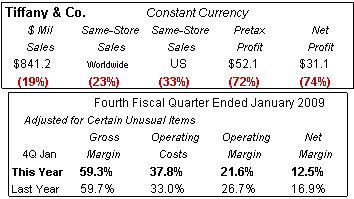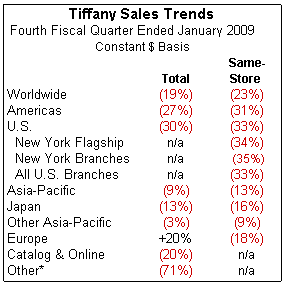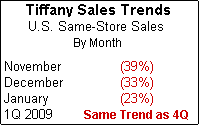IDEX Online Research: Jewelry Demand Seems to Have Stabilized for Tiffany
April 02, 09
The media’s doomsday naysayers, along with the bears of the investment world, were probably disappointed with Tiffany’s fourth quarter and full year results. Not only were earnings (excluding unusual items) above management’s forecast, but a drill-down analysis into the company’s sales trends indicates that demand has stabilized, and the trend seems to point toward improving results.
We note that it may have been hard to discern these encouraging bits of news based on the company’s news release, but you need to remember: SEC lawyers dictated how the financial results must be disclosed.
We’re not sugar-coating Tiffany’s results for the fourth quarter and year: they were extremely disappointing. However, they represent a broad view of the period. For example, Tiffany’s U.S. same-store sales declined by a whopping 33 percent in the quarter. Month-by-month, they were down 39 percent in November (versus +7 percent in November 2007); down 33 percent in December (versus -5 percent in December 2007); and, down 23 percent in January (versus flat in January 2008). It is clear that, after adjusting for the prior year’s comparisons, Tiffany’s sales decline has been moderating since its woeful November performance.
However, management did note that the sales decline appears to have hit a plateau in the first quarter – the decline is no worse, nor no better, than fourth quarter trends. In our opinion, that is reason for encouragement. Comparisons against last year are reasonably difficult, with worldwide sales up 8 percent (constant currency) in last year’s first quarter, so a worldwide sales decline of 20 percent or slightly more in the first quarter of this year isn’t as bad as it might seem initially.
Fourth Quarter Results Analysis
The following table summarizes Tiffany’s fourth quarter financial results.

Fourth Quarter Highlights
The following are financial and merchandising highlights from Tiffany’s fourth fiscal quarter ended January 2009.
- Tiffany’s global net sales declined 20 percent in the fourth quarter. However, excluding the impact of currency swings, global net sales declined by 19 percent and global same-store sales declined by 23 percent on a constant currency basis. “Constant currency” comparisons show the underlying demand trends, since currency swings are eliminated. However, GAAP (Generally Accepted Accounting Principles) require companies to report results including currency swings; we believe this distorts results for multi-national companies such as Tiffany.
- Sales in the Americas – including the U.S., Canada, and Latin American/South American stores –declined by 29 percent in the fourth quarter. Difficult economic conditions in the U.S., coupled with heavy price-based promotions by competitors, hurt demand for Tiffany’s merchandise.
- In the U.S. market – 76 stores – total sales declined 30 percent in the fourth quarter, and same-store sales dropped by 33 percent. Both the number of transactions and the average ticket fell in the fourth quarter in Tiffany’s U.S. stores. The table below summarizes additional detail about Tiffany’s U.S. sales as well as sales in other global markets.

Source: Tiffany & Co.
The table below summarizes Tiffany’s U.S. sales by month for its fourth fiscal quarter, and it illustrates current sales trends for the early months of 2009.

Source: Tiffany & Co.
- Tiffany management noted that its sales per gross square foot of store space in its New York Flagship unit were about $6,500 last year. This compares to the typical independent jeweler’s sales of $483 per square foot, according to the Jewelers of America (JA) Cost of Doing Business Survey (2007 edition). Tiffany’s New York Flagship store on Fifth Avenue represents about 10 percent of corporate sales, or about $286 million, more or less. That’s the equivalent of about 285 independent jewelers, based on JA statistics that show the typical independent generates annual sales of just over $1 million. Tiffany is an AGS (American Gem Society) jeweler – these jewelers tend to be higher-end merchants whose methods of doing business are superior to other jewelers; the typical AGS jeweler generates annual per-store sales of just over $2.4 million. Thus, Tiffany’s New York Flagship store generates about the same amount of business as about 120 typical AGS stores.
- Tiffany’s five highest volume stores in 2008 were – in order – 1) South Coast Plaza in Costa Mesa, California; followed by stores in Chicago, San Francisco, Beverly Hills, and the Washington, DC store in Vienna, Virginia.
- Every price strata reflected a sales decline. However, the sales decline was more modest in merchandise priced below $500 and above $50,000.
- In the U.S., sales to Americans declined by about the same amount as sales to overseas tourists. As the U.S. greenback strengthened near the end of 2008, overseas tourists’ trips to the U.S. – along with their spending – declined. For the full year, sales to foreign tourists who shopped in Tiffany’s U.S. stores represented 16 percent of U.S. sales versus 14 percent in 2007 and 11 percent in 2006. The very weak U.S. dollar early in 2008 helped boost tourist spending in the first half.
- Tiffany’s online and catalog sales declined by 20 percent in the quarter due to a lower number of orders shipped. The average ticket held relatively steady. There was a modest decline in the number of catalogs mailed in 2008, a trend that will continue into 2009, as more customers shift to ordering goods online rather than via the catalog.
- In Canada, Tiffany posted “healthy” sales growth in the fourth quarter. This was in stark contrast to Birks & Mayors which posted an 18 percent same-store sales decline for its fourth quarter.
Sales for Tiffany rose in Brazil, but were soft in Mexico during the fourth quarter ended January 2009.
- Sales in Tiffany’s “other” channel declined by 71 percent in the fourth quarter due largely to reduced wholesale sales of diamonds. In addition, results from the under-performing Iridesse pearl stores are included; this division will be shut down gradually during 2009. Sales in the “other” channel were a mere $66.7 million for the year, or about 2.3 percent of corporate revenues, an inconsequential level.
- During 2008, Tiffany opened 22 new stores, and finished the year with 206 locations in 21 countries. This is a 12 percent increase in the number of Tiffany locations, and a 9 percent increase in square footage. The company operates 935,000 gross square feet, including 600,000 in the Americas, 242,000 in the Asia-Pacific region and 93,000 in Europe.
- By merchandise category, high-end statement jewelry sales posted a worse decline than the company average. This correlates to other trends that we are seeing. For example, the Financial Times carried a news story (March 27, 2009) which stated, “For years the conventional wisdom was that large diamonds were the most prized jewelry possessions. Yet attitudes to conspicuous consumption have changed in tandem with the downturn in the global diamond business during the worldwide recession. As a result, consumers’ decisions are more considered: a diamond the size of Manhattan now teeters on the edge of the distasteful, while investors want more for their money than simple stones devoid of design innovation.”
- Sales of fine jewelry collections were also disappointing, with lower unit sales and a decline in the average ticket, particularly in the Americas.
- Engagement jewelry sales were down less than average; bridal is a relatively stable category. Contrary to some media reports, the number of weddings does not decline in recessionary periods.
- Silver and gold jewelry also posted a smaller sales decline than the company average. Management said sales of charm jewelry were strong. Tiffany has introduced a new collection called Tiffany Keys, a collection of pendants in a wide range that spans platinum and diamond, gold, and silver.
- Watch sales were soft for Tiffany in the fourth quarter. However, the company is touting its new relationship with the Swatch Group which will result in new designs and expanded distribution during 2009.
- As a result of the recessionary environment as well as reviewing its total financial outlook, management highlighted the changes it has made in its operations in recent months.
- It closed its diamond facility in Yellowknife Canada due to its high cost and lack of new rough diamond supply opportunities in Canada.
- It offered early retirement to 800 employees, of whom 600 elected to participate.
- The Iridesse pearl division is being phased out.
- Selective staff reductions have been completed.
- Its investment in a diamond mining company has been written down.
- Its new store opening program has been trimmed for 2009. After opening 22 stores in 2008, about 13 units are planned in 2009. In the U.S., three new stores are planned. An additional store is planned in Toronto as well as Mexico. Outside the U.S., a new store is slated to open in Europe, and seven units are scheduled to open in the Asia-Pacific region including China.
- Tiffany’s capital expenditures will likely be about $100 million this year or just under 4 percent of projected sales, down considerably from its normal 6 percent to 7 percent of sales.
- It has suspended the buyback of TIF shares to conserve cash.
- Management’s outlook for this year (fiscal year ending January 2010) is as follows:
- Global sales are expected to decline by about 11 percent to $2.6 billion. This is in the range of the IDEX Online Research sales forecast.
- Sales in the Americas – mostly the U.S. – are expected to decline by a mid-teen percentage. Sales declines will be larger in the first half than the second half of the year.
- Online and catalog sales are expected to decline by a high single-digit percentage.
- In global markets, the company is looking for a 10 percent sales decline in local currency in the Asia-Pacific region, including Japan. In Europe, sales in local currency are expected to be about flat. Wholesale sales of diamonds are expected to be down by about 20 percent for Tiffany. We note that these numbers do not coincide with the numbers that Tiffany reported in its press release. Because of legal regulations, the company must report its estimated sales in dollars; thus, management must guess at demand levels by market and potential currency swings. Even professional financial managers have difficulty guessing currency swings. With Tiffany’s management guidance, we have taken out the forecasted currency swings, and shown forecasts in local currency by market.
- Profits will be under pressure.
- Tiffany is approaching the recessionary environment like any good merchant: as competitors close their doors, it means more market share for Tiffany. Further, since the jewelry business is relatively capital intense, and since capital is scarce, there are likely to be few new entrants into the market.
The company plans a continuing program of new jewelry and collections in order to provide something new for its loyal customer base.